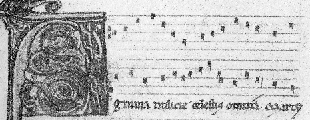 |
PaleospectrophonyNOTE: This initial account of methods for transducing images into sound—first posted in 2009—is maintained here for its historical interest. You can also find it archived in Archive.org's Wayback Machine. For current information, please visit griffonage.com. |
5. Neumatic Musical Notation5.1—Neumatic musical notation often takes a form that graphs time versus frequency to a greater or lesser extent. Because of this, some medieval musical manuscripts arguably lend themselves to paleospectrophonic eduction. I believe this would make them the world's oldest automatically "playable" inscriptions of any kind, though I'm open to arguments to the contrary. I don't claim that these automatically educed versions are more "authentic" than, say, modern performances; however, I think they might prompt some interesting discussions! 5.2—Here's what the opening of the Play of Daniel (Ludus Danielis) sounds like when educed paleospectrophonically from a facsimile of Egerton MS. 2615, dating from about the year 1230: . Ad honorem tui Christi
The sequence and direction of pitch changes is correct, but the exact rhythm and steps are presumably not. Note in particular the flatted note above; paleospectrophony can't accommodate such "arbitrary" markup.
|
 |
5.3—One very promising manuscript for paleospectrophonic purposes is Cod. Sang. 383, available in digital facsimile from the Stiftsbibliothek St. Gall, and dating from before the year 1250. I have educed one complete kyrie, "Clemens rector aeterne," beginning on page 23 and concluding on page 25. If you just want to get a quick sense of what the results sound like, try the "fast" version: . If you want to hear a version at something more closely approximating a typical performance speed, try the "slow" version: Here are two more pages from Cod. Sang. 383, as educed only at "slow" speed: 155: 156: 5.4—All the examples I've tried so far have been diastematic, which is to say, they have staff lines. Earlier adiastematic manuscripts should be playable using this method as well, which I believe ought to allow paleospectrophony to penetrate back well before the year 1000. However, I don't yet have sufficient knowledge of these things myself to set reasonable bottom and top frequency values. 5.5— How does polyphony come out? Here's a brief example from the manuscript Wolfenbüttel 1099 (1206), in astounding medieval stereo:
|


